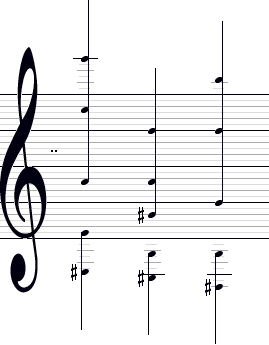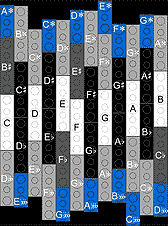⊕ Scale →
Pitches and intervals in the traditional system differ by halfsteps of 12ET. Pitches and intervals in the H-System differ by comma steps of 41ET, fine-tuned in JNDs, resulting in 205ET.
| Traditional | halfstep (h) | 12h = 12ET | |
|---|---|---|---|
| H-System | JND (J) | comma (Ç) = 5J | 41Ç × 5J = 205ET |
Traditional pitch naming uses two attributes: a letter and an optional accidental. The H-System adds two optional attributes: a JND inflection and a comma shift.
| Traditional | letter, accidental | A |
|---|---|---|
| H-System | JND inflection, comma shift, letter, accidental |   A A |
Traditional interval naming uses two attributes: a quality and an ordinal size. The H-System adds two optional attributes: a JND intonation quality and a comma shift type.
| Traditional | quality, ordinal size | m3 |
|---|---|---|
| H-System | JND intonation quality, comma shift type, quality, ordinal size | P.Lm3 |
Traditional notation uses a five line staff where positions correspond to 7 diatonic naturals per octave, and sharps and flats written on the staff are halfstep accidentals. The H-System uses a twenty-five line staff where positions correspond to 41 commas per octave, and sharps and flats written on the staff are JND inflections.
The traditional keyboard has 12 keys per octave, where each key carries multiple enharmonic names as shown below. In the H-System, the keyboard has 41 regions per octave with 5 keys per region making 205 keys per octave. Traditional note names are given unique positions, and new enharmonic keys exist at the top and bottom edges of the layout, the blue keys in the image below.
| Traditional | H-System |
|---|---|
 |
 |
| Traditional | H-System |
 |
 |
|---|